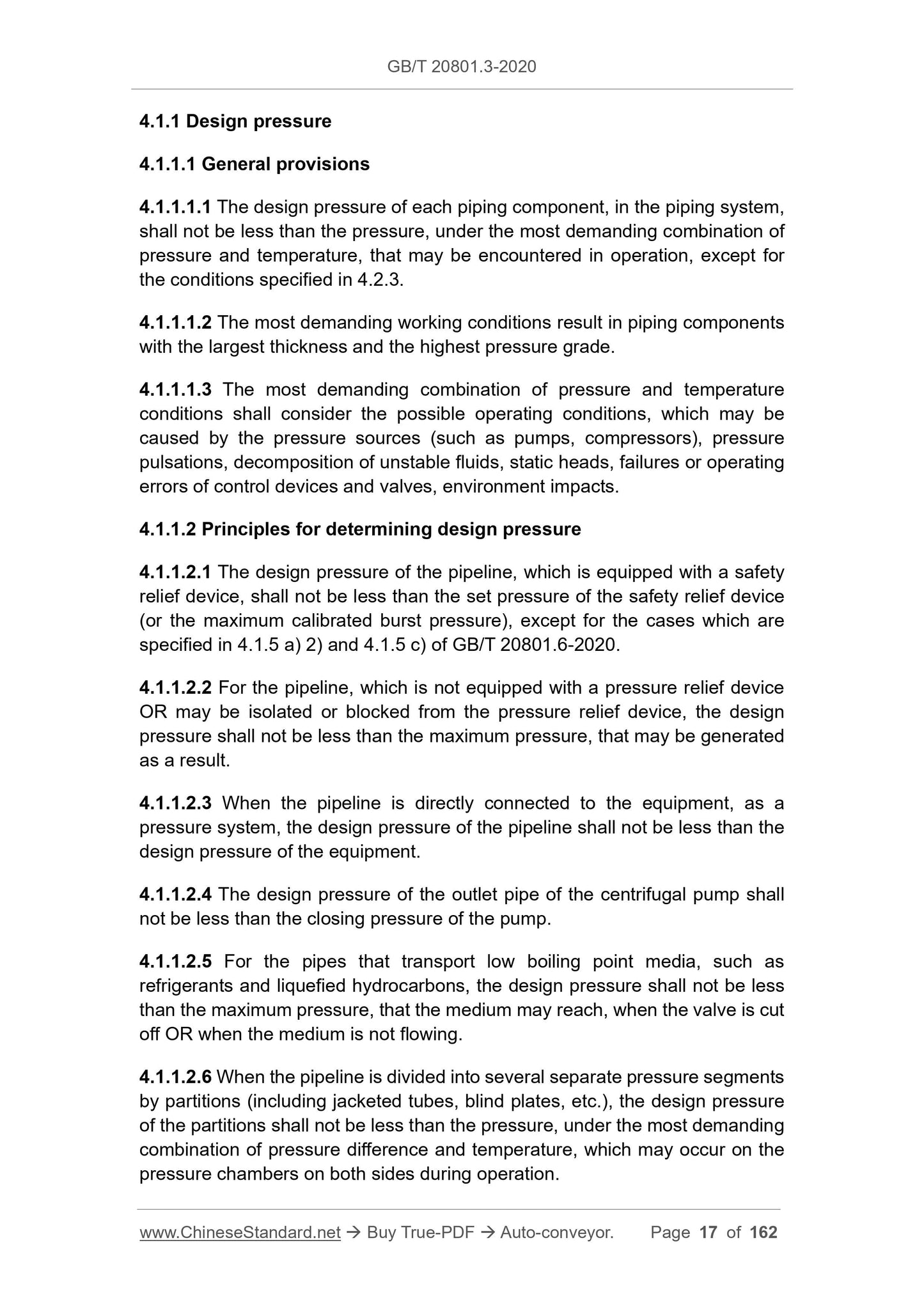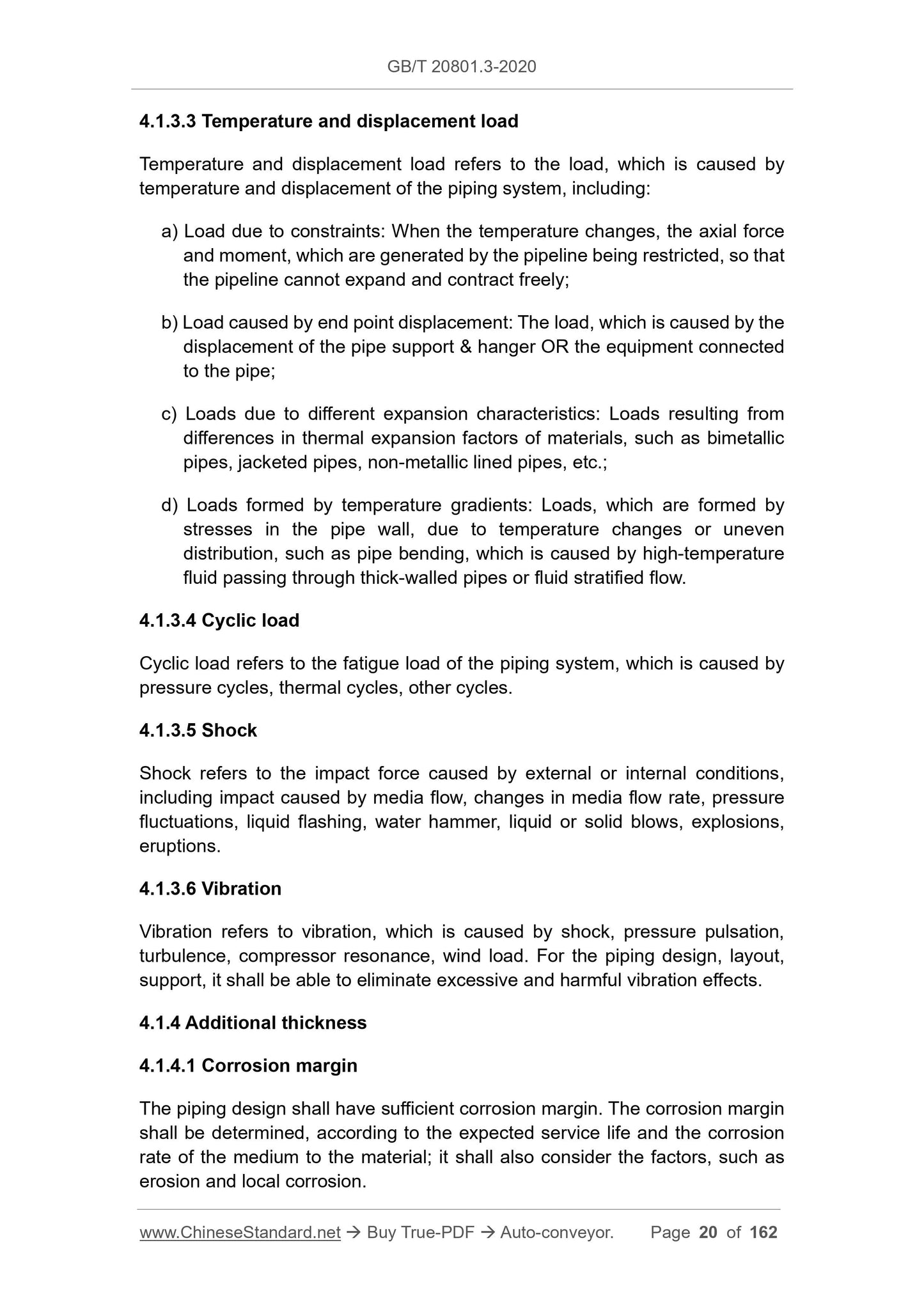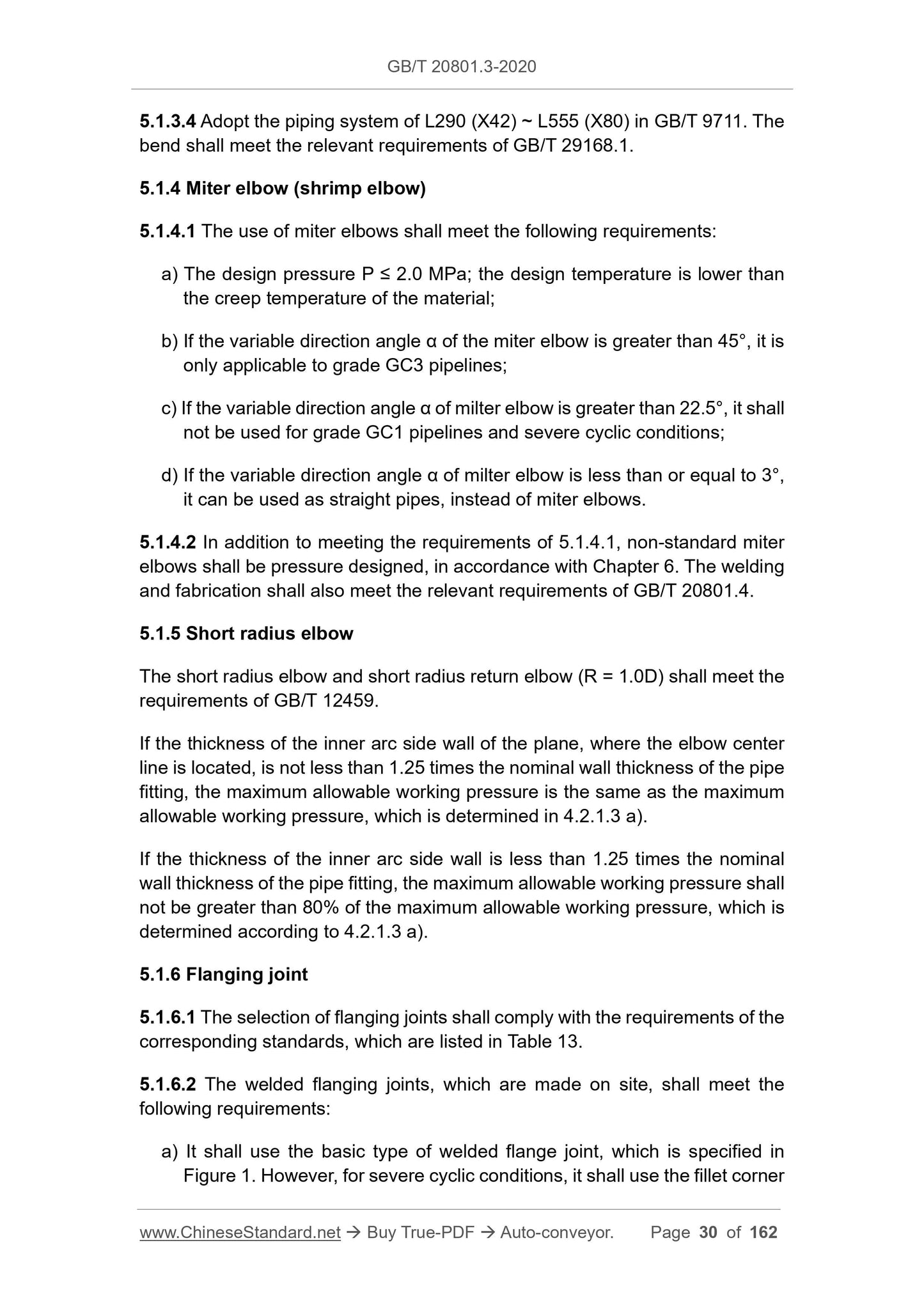1
/
of
11
PayPal, credit cards. Download editable-PDF & invoice In 1 second!
GB/T 20801.3-2020 English PDF (GBT20801.3-2020)
GB/T 20801.3-2020 English PDF (GBT20801.3-2020)
Regular price
$1,330.00 USD
Regular price
Sale price
$1,330.00 USD
Unit price
/
per
Shipping calculated at checkout.
Couldn't load pickup availability
Delivery: 3 seconds. Download true-PDF + Invoice.
Get QUOTATION in 1-minute: Click GB/T 20801.3-2020
Historical versions: GB/T 20801.3-2020
Preview True-PDF (Reload/Scroll if blank)
GB/T 20801.3-2020: Pressure piping code -- Industrial piping -- Part 3: Design and calculation
GB/T 20801.3-2020
GB
NATIONAL STANDARD OF THE
PEOPLE’S REPUBLIC OF CHINA
ICS 23.040
J 74
Replacing GB/T 20801.3-2006
Pressure piping code - Industrial piping - Part 3:
Design and calculation
ISSUED ON: NOVEMBER 19, 2020
IMPLEMENTED ON: JUNE 01, 2021
Issued by: State Administration for Market Regulation;
Standardization Administration of PRC.
Table of Contents
Foreword ... 3
1 Scope ... 6
2 Normative references ... 6
3 Terms and definitions ... 14
4 Design conditions and design criteria ... 16
5 Piping components ... 29
6 Pressure design of piping components ... 50
7 Stress analysis of pipeline ... 70
8 Pipe support and hanger ... 85
Appendix A (Informative) Calculation of wind load and seismic load ... 96
Appendix B (Informative) Piping layout ... 105
Appendix C (Informative) Comparison of common industrial valve standards
with foreign general petrochemical valve standards ... 121
Appendix D (Informative) General requirements for stem seals of low leakage
valves ... 126
Appendix E (Informative) Calculation example ... 129
Appendix F (Informative) Reinforcement calculation by pressure area method
... 140
Appendix G (Normative) Flexibility factor and stress increase factor ... 142
Appendix H (Informative) Dynamic load analysis of valves in piping system
when opening and closing ... 146
Appendix I (Informative) Allowable load of static equipment nozzle ... 151
Appendix J (Normative) Corrugated metal expansion joint ... 154
References ... 162
Pressure piping code - Industrial piping - Part 3:
Design and calculation
1 Scope
This Part of GB/T 20801 specifies the basic requirements for the design and
calculation of pressure pipelines. These basic requirements include design
conditions, design criteria, piping components and their pressure design,
pipeline stress analysis, etc.
This Part applies to the design and calculation of pressure piping, which is
defined within the scope of GB/T 20801.1.
2 Normative references
The following documents are essential to the application of this document. For
the dated documents, only the versions with the dates indicated are applicable
to this document; for the undated documents, only the latest version (including
all the amendments) is applicable to this standard.
GB/T 150 (all parts) Pressure vessel
GB/T 196 General purpose metric screw threads - Basic dimensions
GB/T 197 General purpose metric screw threads - Tolerances
GB/T 1031 Geometrical product specifications (GPS) - Surface texture:
Profile method - Surface roughness parameters and their values
GB/T 1047 Pipework components - Definition and selection of nominal size
GB/T 1048 Pipework components - Definition and selection of PN
GB/T 3287 Malleable cast iron pipe fittings
GB/T 3420 Gray iron castings for pipe fittings
GB/T 3422 Cast-iron pressure pipe made by continuous casting process
GB/T 3733 24° cone connectors - Straight thread
GB/T 3734 24° cone connectors - Male
4.1.1 Design pressure
4.1.1.1 General provisions
4.1.1.1.1 The design pressure of each piping component, in the piping system,
shall not be less than the pressure, under the most demanding combination of
pressure and temperature, that may be encountered in operation, except for
the conditions specified in 4.2.3.
4.1.1.1.2 The most demanding working conditions result in piping components
with the largest thickness and the highest pressure grade.
4.1.1.1.3 The most demanding combination of pressure and temperature
conditions shall consider the possible operating conditions, which may be
caused by the pressure sources (such as pumps, compressors), pressure
pulsations, decomposition of unstable fluids, static heads, failures or operating
errors of control devices and valves, environment impacts.
4.1.1.2 Principles for determining design pressure
4.1.1.2.1 The design pressure of the pipeline, which is equipped with a safety
relief device, shall not be less than the set pressure of the safety relief device
(or the maximum calibrated burst pressure), except for the cases which are
specified in 4.1.5 a) 2) and 4.1.5 c) of GB/T 20801.6-2020.
4.1.1.2.2 For the pipeline, which is not equipped with a pressure relief device
OR may be isolated or blocked from the pressure relief device, the design
pressure shall not be less than the maximum pressure, that may be generated
as a result.
4.1.1.2.3 When the pipeline is directly connected to the equipment, as a
pressure system, the design pressure of the pipeline shall not be less than the
design pressure of the equipment.
4.1.1.2.4 The design pressure of the outlet pipe of the centrifugal pump shall
not be less than the closing pressure of the pump.
4.1.1.2.5 For the pipes that transport low boiling point media, such as
refrigerants and liquefied hydrocarbons, the design pressure shall not be less
than the maximum pressure, that the medium may reach, when the valve is cut
off OR when the medium is not flowing.
4.1.1.2.6 When the pipeline is divided into several separate pressure segments
by partitions (including jacketed tubes, blind plates, etc.), the design pressure
of the partitions shall not be less than the pressure, under the most demanding
combination of pressure difference and temperature, which may occur on the
pressure chambers on both sides during operation.
4.1.1.2.7 For vacuum pipelines, which are equipped with safety control devices,
the design pressure shall be 1.25 times the maximum pressure difference OR
0.1 MPa (whichever is smaller), AND be designed according to external
pressure conditions. For vacuum pipelines without safety control devices, the
design pressure takes 0.1 MPa.
4.1.2 Design temperature
4.1.2.1 General provisions
4.1.2.1.1 The design temperature of each piping component, in the piping
system, shall be determined, according to the temperature, under the most
demanding combination of pressure and temperature, that may be encountered
in operation.
4.1.2.1.2 The design temperature of different piping components, in the same
piping, can be different.
4.1.2.1.3 When determining the design temperature, it shall consider the
influence of fluid temperature, ambient temperature, sunlight radiation, heating
or cooling medium temperature, pipeline insulation, heat transfer.
4.1.2.2 Principles for determining the design temperature
4.1.2.2.1 For pipelines without external thermal insulation, when the medium
temperature is lower than 65 °C, the design temperature of the piping
components is the same as the medium temperature; however, it shall consider
the sunlight radiation or other factors that may cause the medium temperature
to rise. When the temperature is higher than or equal to 65 °C, the design
temperature of the piping components shall be determined, in accordance with
the following requirements:
a) For valves, pipes, flanged ends, welded pipe fittings, take 95% of the
medium temperature;
b) For flanges other than loose flanges, take 90% of the medium temperature;
c) For loose flanges, take 85% of the medium temperature;
d) For bolts, take 80% of the medium temperature;
e) It is also possible to take the measured average wall temperature or the
average wall temperature, which is calculated based on heat transfer.
4.1.2.2.2 The design temperature of the external insulated pipe is generally
taken as the medium temperature. However, it can also be taken from the
measur...
Get QUOTATION in 1-minute: Click GB/T 20801.3-2020
Historical versions: GB/T 20801.3-2020
Preview True-PDF (Reload/Scroll if blank)
GB/T 20801.3-2020: Pressure piping code -- Industrial piping -- Part 3: Design and calculation
GB/T 20801.3-2020
GB
NATIONAL STANDARD OF THE
PEOPLE’S REPUBLIC OF CHINA
ICS 23.040
J 74
Replacing GB/T 20801.3-2006
Pressure piping code - Industrial piping - Part 3:
Design and calculation
ISSUED ON: NOVEMBER 19, 2020
IMPLEMENTED ON: JUNE 01, 2021
Issued by: State Administration for Market Regulation;
Standardization Administration of PRC.
Table of Contents
Foreword ... 3
1 Scope ... 6
2 Normative references ... 6
3 Terms and definitions ... 14
4 Design conditions and design criteria ... 16
5 Piping components ... 29
6 Pressure design of piping components ... 50
7 Stress analysis of pipeline ... 70
8 Pipe support and hanger ... 85
Appendix A (Informative) Calculation of wind load and seismic load ... 96
Appendix B (Informative) Piping layout ... 105
Appendix C (Informative) Comparison of common industrial valve standards
with foreign general petrochemical valve standards ... 121
Appendix D (Informative) General requirements for stem seals of low leakage
valves ... 126
Appendix E (Informative) Calculation example ... 129
Appendix F (Informative) Reinforcement calculation by pressure area method
... 140
Appendix G (Normative) Flexibility factor and stress increase factor ... 142
Appendix H (Informative) Dynamic load analysis of valves in piping system
when opening and closing ... 146
Appendix I (Informative) Allowable load of static equipment nozzle ... 151
Appendix J (Normative) Corrugated metal expansion joint ... 154
References ... 162
Pressure piping code - Industrial piping - Part 3:
Design and calculation
1 Scope
This Part of GB/T 20801 specifies the basic requirements for the design and
calculation of pressure pipelines. These basic requirements include design
conditions, design criteria, piping components and their pressure design,
pipeline stress analysis, etc.
This Part applies to the design and calculation of pressure piping, which is
defined within the scope of GB/T 20801.1.
2 Normative references
The following documents are essential to the application of this document. For
the dated documents, only the versions with the dates indicated are applicable
to this document; for the undated documents, only the latest version (including
all the amendments) is applicable to this standard.
GB/T 150 (all parts) Pressure vessel
GB/T 196 General purpose metric screw threads - Basic dimensions
GB/T 197 General purpose metric screw threads - Tolerances
GB/T 1031 Geometrical product specifications (GPS) - Surface texture:
Profile method - Surface roughness parameters and their values
GB/T 1047 Pipework components - Definition and selection of nominal size
GB/T 1048 Pipework components - Definition and selection of PN
GB/T 3287 Malleable cast iron pipe fittings
GB/T 3420 Gray iron castings for pipe fittings
GB/T 3422 Cast-iron pressure pipe made by continuous casting process
GB/T 3733 24° cone connectors - Straight thread
GB/T 3734 24° cone connectors - Male
4.1.1 Design pressure
4.1.1.1 General provisions
4.1.1.1.1 The design pressure of each piping component, in the piping system,
shall not be less than the pressure, under the most demanding combination of
pressure and temperature, that may be encountered in operation, except for
the conditions specified in 4.2.3.
4.1.1.1.2 The most demanding working conditions result in piping components
with the largest thickness and the highest pressure grade.
4.1.1.1.3 The most demanding combination of pressure and temperature
conditions shall consider the possible operating conditions, which may be
caused by the pressure sources (such as pumps, compressors), pressure
pulsations, decomposition of unstable fluids, static heads, failures or operating
errors of control devices and valves, environment impacts.
4.1.1.2 Principles for determining design pressure
4.1.1.2.1 The design pressure of the pipeline, which is equipped with a safety
relief device, shall not be less than the set pressure of the safety relief device
(or the maximum calibrated burst pressure), except for the cases which are
specified in 4.1.5 a) 2) and 4.1.5 c) of GB/T 20801.6-2020.
4.1.1.2.2 For the pipeline, which is not equipped with a pressure relief device
OR may be isolated or blocked from the pressure relief device, the design
pressure shall not be less than the maximum pressure, that may be generated
as a result.
4.1.1.2.3 When the pipeline is directly connected to the equipment, as a
pressure system, the design pressure of the pipeline shall not be less than the
design pressure of the equipment.
4.1.1.2.4 The design pressure of the outlet pipe of the centrifugal pump shall
not be less than the closing pressure of the pump.
4.1.1.2.5 For the pipes that transport low boiling point media, such as
refrigerants and liquefied hydrocarbons, the design pressure shall not be less
than the maximum pressure, that the medium may reach, when the valve is cut
off OR when the medium is not flowing.
4.1.1.2.6 When the pipeline is divided into several separate pressure segments
by partitions (including jacketed tubes, blind plates, etc.), the design pressure
of the partitions shall not be less than the pressure, under the most demanding
combination of pressure difference and temperature, which may occur on the
pressure chambers on both sides during operation.
4.1.1.2.7 For vacuum pipelines, which are equipped with safety control devices,
the design pressure shall be 1.25 times the maximum pressure difference OR
0.1 MPa (whichever is smaller), AND be designed according to external
pressure conditions. For vacuum pipelines without safety control devices, the
design pressure takes 0.1 MPa.
4.1.2 Design temperature
4.1.2.1 General provisions
4.1.2.1.1 The design temperature of each piping component, in the piping
system, shall be determined, according to the temperature, under the most
demanding combination of pressure and temperature, that may be encountered
in operation.
4.1.2.1.2 The design temperature of different piping components, in the same
piping, can be different.
4.1.2.1.3 When determining the design temperature, it shall consider the
influence of fluid temperature, ambient temperature, sunlight radiation, heating
or cooling medium temperature, pipeline insulation, heat transfer.
4.1.2.2 Principles for determining the design temperature
4.1.2.2.1 For pipelines without external thermal insulation, when the medium
temperature is lower than 65 °C, the design temperature of the piping
components is the same as the medium temperature; however, it shall consider
the sunlight radiation or other factors that may cause the medium temperature
to rise. When the temperature is higher than or equal to 65 °C, the design
temperature of the piping components shall be determined, in accordance with
the following requirements:
a) For valves, pipes, flanged ends, welded pipe fittings, take 95% of the
medium temperature;
b) For flanges other than loose flanges, take 90% of the medium temperature;
c) For loose flanges, take 85% of the medium temperature;
d) For bolts, take 80% of the medium temperature;
e) It is also possible to take the measured average wall temperature or the
average wall temperature, which is calculated based on heat transfer.
4.1.2.2.2 The design temperature of the external insulated pipe is generally
taken as the medium temperature. However, it can also be taken from the
measur...
Share






















